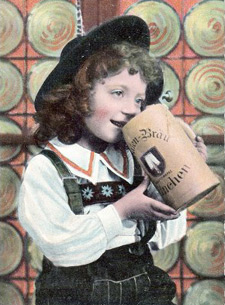 Why would a German beer drinker pay the equivalent of $4.20 for a 12-ounce bottle of Brooklyn Lager? It’s an excellent beer, but that’s quite a markup over what it costs in the United States and considerably more than Germans pay from any of several outstanding beers.
Why would a German beer drinker pay the equivalent of $4.20 for a 12-ounce bottle of Brooklyn Lager? It’s an excellent beer, but that’s quite a markup over what it costs in the United States and considerably more than Germans pay from any of several outstanding beers.
I don’t have an answer.
Maybe it is somehow related to the fact Berlin Is a Haven of Hip. Consider this from a Washington Post story that got a lot of attention last week: “At a recent tasting in one Berlin bar, guests sipped craft beers out of special vessels shaped like wineglasses that helped concentrate the aromas of the brew. The bar was furnished in a decidedly Berlin style — it was a subterranean lair where beakers of bubbling fluorescent liquids served as decoration, the tables appeared to be made from welded-together car parts, and fake stalactites hung from the ceiling.”
Not quite like drinking beer in Franconia.
That’s not actually what struck me first when I read the story, and compressed a bunch of words into something almost meaningless on Twitter. It was the simple arrogance of this.
“The German beer industry has to reinvent itself in a hurry, or it’s going to be a small fraction of what it is now,” said Eric Ottaway, the general manager of Brooklyn Brewery, which has been expanding in Europe and has been exporting its beer to Germany through Braufactum, which sells a 12-ounce bottle of Brooklyn Lager in upscale grocery stores for the equivalent of $4.20 — almost three times its typical American price.
And this.
“This was simply to fill a void,” he said. “We feel as if we’re teaching a lot of Germans things about their own beer culture that they’ve forgotten.”
He is Matt Walthall, one of three American expats who have launched a crowdfunding campaign to raise enough money to open a brewery.
German drinkers sure are lucky those guys showed up.
OK, that was snide. Steam blown off. A lot of good in that story, and to be fair, Ottaway has a point. Reinvent itself is a bit strong, but German brewers need to make changes. Oh, wait, some are. Those particular ones just aren’t in this story. So a few links to fill in the gaps:
– Sylvia Kopp’s excellent story from five years ago in All About Beer magazine: Ruled by the Reinheitsgebot?
– The (Real) Beer Nut’s up-to-date report from Munich called The shape of things to come.
– An article in the 2012/2013 edition of Hopfen (a pdf) about the Bier-Quer-Denker workshops gives you a good idea of who well attended they’ve become.